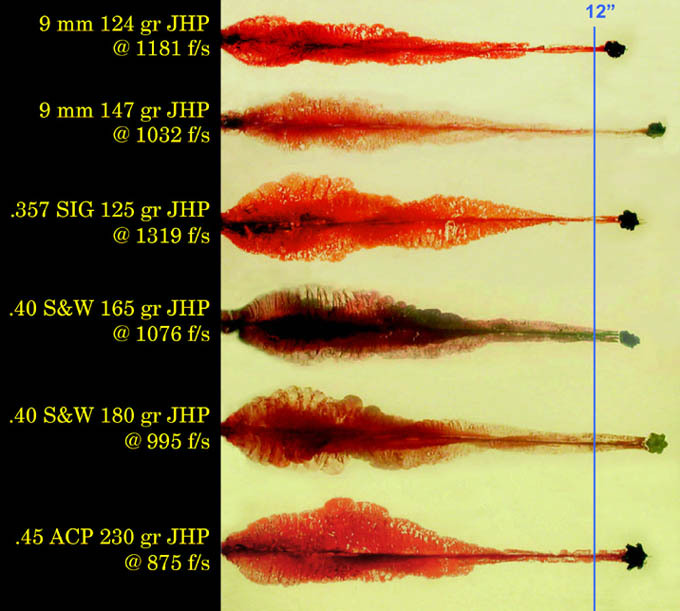Well again guys , im sorry I donít have photos anymore of the penetration tests on jell .
thatís been along time ago .
What I can tell you is what I saw is what has me a firm believer in the 100 yard rule
Something you will see in these jell tests that you donít see when firing into wood or paper is that a projectile leave 2 different wound channels . Some of you have heard me speak of this before .
1) is the primary or permanent cavity
2) is the secondary or temerity cavity
The first is the actual channel made by the projectile passing through the object . That what your seeing in the leather targets Blue lake posted as well as the hole in paper phone books or , water jugs , or what have you .
The second is caused by energy transfer not bullet deformation . HOWEVER if the projectile deform prior to contact then you get a larger primary and secondary because the larger area of the projectile , creates a larger area of energy transfer,. However in doing so , the expansion also reduces the penetrating ability of the projectile do to large are a of friction that gets applied to the projectile . So basically in simple terms. A projectile that holds together will penetrate deeper then a projectile that expands. When fired from the same charge . This is because the total energy is contained more to the projectile then transferring into the target
This is what you see when center fire hunting when folks state the lost the shoulder from bruising or blood clotting. This energy transfer causes a disruption of tissue , blood vassals and nerves .
When firing into jell , you will see this
Here is a high velocity bullet test into jell that shows the primary and secondary wounds clearly .

Now here is where we run into a rub .. If when doing your tests you donít use a medium that properly simulates the target you will be shooting at your test will be off , in fact most time WAY off .
Take the leather that blue lakes shot into .
As I understand it , what he was trying to find out , was how well a RB penetrated the leather armor of a soldier of that period .
However its important to realize that while this leather patch might represent the leather armor well .
If he hung it or even mounted it say to a board , his results will be off . Not just in penetration but also in seeing the effects of that penetration on the projectile .
Why ? Because as I mentioned before with steel targets . The resistance is different which changes the energy transfer .
The armor supported / backed by say a human body is not ridged . But at the same time its not fluid like if the leather patch was simply hung from a target stand .
See most folks misunderstand what a bullet does . See we see a hole and we thing WOW!!! look at that . The bullet cut right through that .
But we are wrong . A bullet doesnít cut or drill its way through . It actually stretches its target to the point the target gives .
so we can draw a wrong conclussion when whe shoot into a more solid target . tissue doesnt act this way , it grabs onto and drags the projetile down .
As a comparison . If you take a balloon and place you finger against it and push , what happens ? The balloon stretches .. The harder you push ď apply more energy , the cavity caused by the elasticity of the balloon gets deeper right . . If you apply enough energy , the rubber the balloon is made from cant take it and it tears away . Tissue is some ways is like that balloon in that as the projectile enters it stretches then fails thus the bullet penetrates .. but at the same time as the projectile passes through tussue that more resitand or denser . it uses more of its stored energy to push and tear its way through
Here is a jell test showing that effect. now this is part of a time laps photo taken while the projectile is moving . thats why the wound channel looks as it does . basicly it hasnt had the split secounds needed to close back up and settle .
If you notice on the right edge of this jell test is a material to simulate skin / Hide. notice the cavity behind it . This is caused by the projectile stretching in the hide until such time it cant take the energy anymore . The rest is the primary and secondary wound , showing the effect of the projectile on the softer tissue
Courtesy of Fire arms ID.com

So if the reaction of that tissue isnít accurately represented , your results will be off , not only on penetration but the deformation of that bullet .
This is why materials like Duxseal is no longer used any longer . Because it does not properly simulate the effects of tissue , either in wound channel or in effects to the bullet itself
A Dr named Foster did a write up as well as a video back in the 1970 that showed the differences using poor mediums to test penetration.
Firearms ID .com has the last 12 minutes of that movie posted on their web site ..
Here is the link . Its alittle slow to run and its granny but its well worth watching .
He shows the difference of the effects on both wound and penetration as well as projectile deformity in jell Vs Duxseal
http://www.firearmsid.com/Gelatin/index.htm This very thing is what we ran into with our jell test in the mid 1990ís and is why after doing such tests proper certified jell was needed to confirm or disprove what was found ..
As a note here. the certified tests actually produced less then what we found with our homemade jell . .
Because the quality of our jell was not adequacy right to withstand the scrutiny of a more scientific evaluation .But what our homemade jell did do was allow us a base of study to start off with , that was much cheaper then certified jell .
now TC has some bolistics test . but they are on modern muzzleloading using modern bullets .
myself , i was less then impressed with the results they found even at 25 yards .
however what the tests did show was the effects of velocity at closer range . which as i stated in my first post , has a large effect on performance especially at high velocities .
Now one would think that closer would equivocate to more penetration. But that many times is not the case especially with soft lead .
see what happens here is that as the velocity increases the lead is less able to stay solid or compact . When it contacts at that velocity it easily mushrooms ? Spreads . Again while this transfers large amounts of energy quickly , it also effect the penetration ability of the bullet.
Now myself IMO I believe this is why we see so many complaints about the RB in 50 and 45 cal . Not dropping big game at close ranges . The tail is in the velocity and the stability of soft lead at that velocity .
I think to often folks look to higher loads so as to raise the energy of a RB at say 100 yards . Which can be a good thing at 100 yards where the velocity has dropped and the lead became more stable .
BUT what they donít get is that say with the 45 cal shooting 100 to 120 grains of powder , the muzzle velocity is such that its tickling the limit and in many cases exceeding the stability for lead . When that happens say at 35 to 50 yards the ball simply is not capable of staying completely intact . It can spread and thus fracture or reduce penetration.
I think this explains why sometimes folks say :
==================================
I donít like the RB . I shot a deer at 35 yards one time and knocked it down . But it got up , ran off and I never found it .
=====================================
Now I could be wrong here as this is just my opinion but . I think there is a great possibility that in such a case the soft lead ball simply expanded and transferred its energy to quickly thus not allowing it to penetrate to a depth needed to reach the vitals or at the very least have the effect on the vitals that it should have been about to do rather quickly .
Here is a link to the TC tests if anyone is interested .
It is IMO a very good read and sheds some light on what im am basing my opinion on above
http://www.theoutdoorquest.com/perma-gel_ballistic_g...



